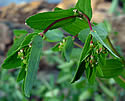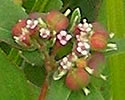Euphorbia nutans (Nodding Spurge)
| Also known as: | Eyebane, Spotted Spurge |
|---|---|
| Genus: | Euphorbia |
| Family: | Euphorbiaceae (Spurge) |
| Life cycle: | annual, short-lived perennial |
| Origin: | native |
| Habitat: | sun; dry to moist disturbed soil; along shores, fields, roadsides, waste areas, lawns, gardens |
| Bloom season: | June - October |
| Plant height: | 6 to 30 inches |
| Wetland Indicator Status: | GP: FACU MW: FACU NCNE: FACU |
| MN county distribution (click map to enlarge): |  |
| National distribution (click map to enlarge): |  |
Pick an image for a larger view. See the glossary for icon descriptions.
Detailed Information
Flower: 

![[photo of flowers]](/udata/r9ndp23q/white/euphorbia-nutans-nodding-spurge_0820_162534-t.jpg) Flowers are small but distinct, mostly in clusters at the tips of branches, few in the lower leaf axils. A small cup, 1/8 inch across, holds the male and female flowers in the center. The rim of the cup has 4 white to pink, rounded petal-like appendages, each a thickened gland at the base that is green to red. The male flower anthers are yellow and nearly indistinct. The clump of styles of the single female flower in the center sit atop a round, 3-parted ovary on a short stalk that extends out from the flower center. Both the floral cup and the developing ovary are often blushed with red. The structure of this flower is called a “cyathium” and is common to all the Euphorbias.
Flowers are small but distinct, mostly in clusters at the tips of branches, few in the lower leaf axils. A small cup, 1/8 inch across, holds the male and female flowers in the center. The rim of the cup has 4 white to pink, rounded petal-like appendages, each a thickened gland at the base that is green to red. The male flower anthers are yellow and nearly indistinct. The clump of styles of the single female flower in the center sit atop a round, 3-parted ovary on a short stalk that extends out from the flower center. Both the floral cup and the developing ovary are often blushed with red. The structure of this flower is called a “cyathium” and is common to all the Euphorbias.
Leaves and stems: 

![[photo of leaves]](/udata/r9ndp23q/pd/euphorbia-nutans-15-t.jpg) Leaves are opposite, oblong to oval oblong, 1/3 to 1 1/3 inch long and a third as wide, blunt or rounded at the tip, mostly stalkless or very short stalked, conspicuously asymmetrical sometimes with a shallow but distinct lobe on one side at the base. Leaf edges are variably toothed, mostly coarsely serrated all around the edge but sometimes only at the tip or on one side, or occasionally completely toothless. Surfaces on young leaves are covered with fine curled hairs, often in a single row, becoming hairless with age. The lower surface is typically light green and infrequently there is a splotch of red mid-leaf on the upper surface. Stems are often red colored, hairy on new growth, becoming smooth with age. The lower stem is erect though more spreading in the upper plant, and often drooping at the branch tips. Leaves and stems exude a milky sap when broken.
Leaves are opposite, oblong to oval oblong, 1/3 to 1 1/3 inch long and a third as wide, blunt or rounded at the tip, mostly stalkless or very short stalked, conspicuously asymmetrical sometimes with a shallow but distinct lobe on one side at the base. Leaf edges are variably toothed, mostly coarsely serrated all around the edge but sometimes only at the tip or on one side, or occasionally completely toothless. Surfaces on young leaves are covered with fine curled hairs, often in a single row, becoming hairless with age. The lower surface is typically light green and infrequently there is a splotch of red mid-leaf on the upper surface. Stems are often red colored, hairy on new growth, becoming smooth with age. The lower stem is erect though more spreading in the upper plant, and often drooping at the branch tips. Leaves and stems exude a milky sap when broken.
Fruit: 
![[photo of fruit]](/udata/r9ndp23q/pd/euphorbia-nutans-9-t.jpg) Fruit is a 3-sectioned capsule, strongly 3-sided, stalked, 1/10 inch wide, that develops rapidly from the center of the cyathium, the clump of styles persisting at the tip. The capsule initially hangs down, becoming erect at maturity, and is typically tinged red. Each section contains a single seed.
Fruit is a 3-sectioned capsule, strongly 3-sided, stalked, 1/10 inch wide, that develops rapidly from the center of the cyathium, the clump of styles persisting at the tip. The capsule initially hangs down, becoming erect at maturity, and is typically tinged red. Each section contains a single seed.
![[photo of seeds]](/udata/r9ndp23q/pd/euphorbia-nutans-103116-t.jpg) Seeds are oval-oblong, angular with rounded angles in cross-section, 1 to 1.6 mm long, slightly wavy on the surfaces, dark brown sometimes with a paler coating that may persist only along the angles.
Seeds are oval-oblong, angular with rounded angles in cross-section, 1 to 1.6 mm long, slightly wavy on the surfaces, dark brown sometimes with a paler coating that may persist only along the angles.
Notes:
Nodding Spurge, formerly known as Chamaesyce nutans, is relatively common throughout SE Minnesota, though often overlooked. While it can become locally weedy in gardens and lawns in both dry and moist locations, historically it appears to have a strong affinity for sandy soils along lake shores and river banks. It is fairly easily distinguished from the other spurges by its open, upright to spreading branches with nodding tips. While in some areas of the country it can grow to heights of over 2 feet, it more commonly stays under a foot tall in Minnesota.
Native Plant Nurseries, Restoration and Landscaping Services ↓
More photos
 Nodding Spurge plant
Nodding Spurge plant Nodding Spurge plant
Nodding Spurge plant the “nodding” part
the “nodding” part more plants
more plants early growth with red-spotted leaves
early growth with red-spotted leaves
Photos by K. Chayka taken in Ramsey and Wabasha counties. Photos courtesy Peter M. Dziuk taken in Anoka, Dakota and Ramsey counties.
Comments
Have you seen this plant in Minnesota, or have any other comments about it?
on: 2020-08-23 10:12:05
Growing in on the edge of a brushy area in my backyard. Cute little plant, but I would like to know if it's native. Should I pull this plant?
on: 2020-08-23 14:22:41
Linda, look at the Plant Info table at the top of the page, which tells you species origin, i.e. whether it is native or not. This one is.






